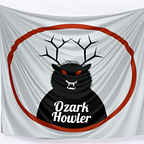Southern Enemies: Christianity and the Ozark Howler
In all the long debates about the place of the Ozark Howler in Southern folklore, there’s an elephant in the room that nobody wants to talk about. It’s the main reason that so many people come forward, objecting to the retelling of traditional Ozark Howler stories:
The Ozark Howler and Southern Christianity are mortal enemies.
Think about it for just a minute, and it’s obvious that the conflict is inevitable. The public face of the American South is a Christian face. Just about every town in the Ozarks claims to be “the buckle of the Bible Belt”.
Underneath this Christian facade, however, there’s another side to Southern culture. The fact is that it wasn’t just Christian religion that came over with European settlers. Old, pre-Christian, pagan British traditions that had never really been wiped out crossed over the Atlantic too.
An Ancient Animosity
Among these traditions was the belief in supernatural beasts that crossed between the mundane world of everyday human life and the realm of Awen, a shadow world of magic, prophecy, music, insight, and artistry. Of these beasts were the Cu Sith, gigantic dark creatures something like huge dogs, but with additional magical characteristics that no mere hound could ever possess.
When Christianity came to the British Isles, it had to compete against these native religious beliefs. In some places, Christian missionaries found it easier to co-opt the old religion, and in in these locales, the old messengers between Awen and the world of the mundane were transformed into church grims, depicted as spooky but basically benevolent guardians of the churchyard, protecting it from other supposedly demonic (native religious) spirits.
In other places, the mysterious black beasts of Britain were cast as purely evil, and enemies of the Christian church. In some cases, the anti-church attacks of these shaggy representatives of the old religion were reported to be quite literal. On August 4 of 1577 in the town of Bungay in Suffolk, England, a gigantic dog-like beast with glowing red eyes and thick black fur was reported to have summoned a terrible thunderstorm attack and then burst into a local church, where it burned people with the infernal blaze of its body, strangled people with its paws, and ripped out people’s throats.
The written account by Abraham Fleming of the attack on the church reads: “All down the church in midst of fire, the hellish monster flew, and, passing onward to the quire, he many people slew…” Next, with what was then depicted as the power of Satan, the beast magically transported itself several miles away to attack another church in Blythburg.
A Southern Conflict
In the Southeastern United States, settlers from England, Scotland, and Wales found themselves confronted with fears of pagan subversion of Christianity again as they met native populations, enslaved Africans, and people from other European countries whose languages they didn’t understand. The Black Dog mythology that had evolved from pre-Christian British beliefs came along with them, and across the Mississippi River, morphed into the Ozark Howler as it adapted to these new influences as well.
Soon, preachers across the Ozarks were delivering fiery sermons against belief in the Ozark Howler. In 1869, R.D. Bradley, pastor of the Methodist Episcopal Church in Webster County, Missouri, warned his congregation against accepting the beliefs and practices that had become prominent throughout the area, saying, “The Bible forbids of followers Christ from practicing superstition. The Lord has abandoned these people. They are full of superstitions from the hills, of black howlers and even darker witchcraft!”
This warning, some say, was prophetic, as in 1878, in an attack remarkably like that of against the church in Bungay, England, the Ozark Howler was said to have attacked the Methodist Episcopal Church during a storm that was so fierce that it blew off the roof entirely. This attack was followed a few decades later by a fire in 1908, burning down the Cumberland Presbyterian Church in Russellville, Arkansas. The fire was blamed on the Ozark Howler.
In more recent times, a network of church activists has organized around the mission of eliminating the teaching of Ozark folktales, including those of the Ozark Howler, from public schools. The Ozark League Against Superstition has distributed leaflets quoting the New Testament: “What is sacrificed to idols is offered to demons, not to God. And I do not want you to share anything with demons. You cannot drink the cup of the Lord and the cup of demons also. You cannot share in the Lord’s table and the table of demons. It is time for the feast of gowrows, snawfuses and mountain howlers to end!”
For generations, many Christians in the Ozarks have been able to balance their belief in local spirits and supernatural beasts such as the Ozark Howler with their Christianity. For just as long, however, church authorities have attempted to purge the region of these folk beliefs, as they are perceived as competition with the worship of Jesus.
Which side will win this lengthy battle?
